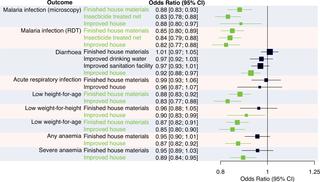PLOS Medicine ( IF 10.5 ) Pub Date : 2020-03-23 , DOI: 10.1371/journal.pmed.1003055 Lucy S Tusting 1 , Peter W Gething 2 , Harry S Gibson 2 , Brian Greenwood 1 , Jakob Knudsen 3 , Steve W Lindsay 4 , Samir Bhatt 2, 5

|
Background
Housing is essential to human well-being but neglected in global health. Today, housing in Africa is rapidly improving alongside economic development, creating an urgent need to understand how these changes can benefit health. We hypothesised that improved housing is associated with better health in children living in sub-Saharan Africa (SSA). We conducted a cross-sectional analysis of housing conditions relative to a range of child health outcomes in SSA.
Methods and findings
Cross-sectional data were analysed for 824,694 children surveyed in 54 Demographic and Health Surveys, 21 Malaria Indicator Surveys, and two AIDS Indicator Surveys conducted in 33 countries between 2001 and 2017 that measured malaria infection by microscopy or rapid diagnostic test (RDT), diarrhoea, acute respiratory infections (ARIs), stunting, wasting, underweight, or anaemia in children aged 0–5 years. The mean age of children was 2.5 years, and 49.7% were female. Housing was categorised into a binary variable based on a United Nations definition comparing improved housing (with improved drinking water, improved sanitation, sufficient living area, and finished building materials) versus unimproved housing (all other houses). Associations between house type and child health outcomes were determined using conditional logistic regression within surveys, adjusting for prespecified covariables including age, sex, household wealth, insecticide-treated bed net use, and vaccination status. Individual survey odds ratios (ORs) were pooled using random-effects meta-analysis. Across surveys, improved housing was associated with 8%–18% lower odds of all outcomes except ARI (malaria infection by microscopy: adjusted OR [aOR] 0.88, 95% confidence intervals [CIs] 0.80–0.97, p = 0.01; malaria infection by RDT: aOR 0.82, 95% CI 0.77–0.88, p < 0.001; diarrhoea: aOR 0.92, 95% CI 0.88–0.97, p = 0.001; ARI: aOR 0.96, 95% CI 0.87–1.07, p = 0.49; stunting: aOR 0.83, 95% CI 0.77–0.88, p < 0.001; wasting: aOR 0.90, 95% CI 0.83–0.99, p = 0.03; underweight: aOR 0.85, 95% CI 0.80–0.90, p < 0.001; any anaemia: aOR 0.87, 95% CI 0.82–0.92, p < 0.001; severe anaemia: aOR 0.89, 95% CI 0.84–0.95, p < 0.001). In comparison, insecticide-treated net use was associated with 16%–17% lower odds of malaria infection (microscopy: aOR 0.83, 95% CI 0.78–0.88, p < 0.001; RDT: aOR 0.84, 95% CI 0.79–0.88, p < 0.001). Drinking water source and sanitation facility alone were not associated with diarrhoea. The main study limitations are the use of self-reported diarrhoea and ARI, as well as potential residual confounding by socioeconomic position, despite adjustments for household wealth and education.
Conclusions
In this study, we observed that poor housing, which includes inadequate drinking water and sanitation facility, is associated with health outcomes known to increase child mortality in SSA. Improvements to housing may be protective against a number of important childhood infectious diseases as well as poor growth outcomes, with major potential to improve children’s health and survival across SSA.
中文翻译:

撒哈拉以南非洲的住房和儿童健康:横断面分析。
背景
住房对于人类福祉至关重要,但在全球健康中却被忽视。如今,非洲的住房随着经济的发展而迅速改善,迫切需要了解这些变化如何有益于健康。我们假设改善住房状况与生活在撒哈拉以南非洲 (SSA) 的儿童的健康状况改善相关。我们对与 SSA 一系列儿童健康结果相关的住房条件进行了横断面分析。
方法和结果
对 2001 年至 2017 年间在 33 个国家进行的 54 项人口和健康调查、21 项疟疾指标调查和两项艾滋病指标调查中接受调查的 824,694 名儿童的横断面数据进行了分析,通过显微镜或快速诊断测试 (RDT)、腹泻来衡量疟疾感染情况0-5 岁儿童的急性呼吸道感染 (ARIs)、发育迟缓、消瘦、体重不足或贫血。儿童平均年龄为2.5岁,其中49.7%为女性。根据联合国的定义,住房被分类为二元变量,比较改善的住房(改善饮用水、改善卫生设施、足够的居住面积和成品建筑材料)与未改善的住房(所有其他房屋)。房屋类型和儿童健康结果之间的关联是通过调查中的条件逻辑回归确定的,并调整预先指定的协变量,包括年龄、性别、家庭财富、经杀虫剂处理的蚊帐使用情况和疫苗接种状况。使用随机效应荟萃分析汇总个体调查比值比 (OR)。在各项调查中,住房条件的改善与除 ARI 以外的所有结果的几率降低 8%–18% 相关(通过显微镜观察疟疾感染:调整后 OR [aOR] 0.88,95% 置信区间 [CI] 0.80–0.97, p = 0.01;疟疾感染RDT:aOR 0.82,95% CI 0.77–0.88, p < 0.001;腹泻:aOR 0.92,95% CI 0.88–0.97, p = 0.001;ARI:aOR 0.96,95% CI 0.87–1.07, p = 0.49; :aOR 0.83,95% CI 0.77–0.88, p < 0.001;消瘦:aOR 0.90,95% CI 0.83–0.99, p = 0.03;体重不足:aOR 0.85,95% CI 0.80–0.90, p < 0.001; aOR 0.87,95% CI 0.82–0.92, p < 0.001:严重贫血:aOR 0。89,95% CI 0.84–0.95, p < 0.001)。相比之下,使用杀虫剂处理的蚊帐与疟疾感染的几率降低 16%–17% 相关(显微镜检查:aOR 0.83,95% CI 0.78–0.88, p < 0.001;RDT:aOR 0.84,95% CI 0.79–0.88, p < 0.001)。仅饮用水源和卫生设施与腹泻无关。尽管对家庭财富和教育进行了调整,但研究的主要局限性是使用自我报告的腹泻和急性呼吸道感染,以及社会经济地位的潜在残留混杂因素。
结论
在这项研究中,我们观察到,贫困的住房(包括饮用水和卫生设施不足)与已知会增加撒哈拉以南非洲儿童死亡率的健康结果有关。住房的改善可能有助于预防许多重要的儿童传染病以及不良的生长结果,并具有改善整个撒哈拉以南非洲地区儿童的健康和生存的巨大潜力。











































 京公网安备 11010802027423号
京公网安备 11010802027423号